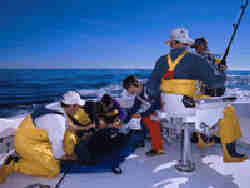
Climate clues from the Earth’s poles – swarming whale food, winners and losers in Antarctic waters, and solar insights at the BA 2002 Annual Meeting
The latest thinking on the chances of extinction for Antarctic animals in seas and lakes, whale food hiding beneath sea ice, and new insights on the Sun’s spin are among the hot topics slated for discussion at today’s Frontiers of Polar Science panel, organized by the American Association for the Advancement of Science (AAAS), through i
Sediments in the Arabian Sea will be examined by an international scientific expedition led by a researcher from the University of Edinburgh to increase understanding of the natural processes of the ocean floor and establish its significance for global cycles and climate change. Robotic research platforms will be deployed on the sea floor to study deep-sea organisms and their impacts on sedimentary processes, without removing the creatures from their natural environment. Monsoons—winds that blow in o

What will some 4,000 of the smartest dressed elephant seals, tuna fish, albatrosses, leatherback sea turtles, great white sharks, and other pelagic megafauna in the Pacific all be wearing in the coming seasons? How about the latest in microprocessor-based electronic tags, some no bigger than oversized cufflinks? It’s all in a continuing effort to understand the habits of marine animals in that part of the world: what exactly lives where and why, what their migration routes and diving behaviors m
In the late 1990s, as scientists were reaching consensus that the Arctic had gone through 30 years of significant climate change, they began reading the first published papers about the Arctic Oscillation, a phenomenon reported to have hemisphere-wide effects.
In short order the arctic-science and the global-change communities were galvanized, says Richard Moritz, polar oceanographer with the UW’s Applied Physics Laboratory and lead author of a review of recent Arctic climate change in

Recent changes in Antarctic seabird populations may be linked to environmental change according to scientists reporting in the journal Science this week. Researchers from the Cambridge-based British Antarctic Survey (BAS) reviewed the best available data from a range of long-term studies to test the view that warming of the Earth`s climate is affecting Antarctic marine life. Whilst they found that sea-ice has a profound influence on population levels of snow petrels, Adélie and emperor penguins, the
A NASA researcher finds that the amount of sea ice that moves between Greenland and Spitsbergen, a group of islands north of Norway, is dependent upon a “wave” of atmospheric pressure at sea level. By being able to estimate how much sea ice is exported through this region, called Fram Strait, scientists may develop further insights into how the ice impacts global climate.
This export of sea ice helps control the thermohaline circulation, a deep water ocean conveyor belt that moves warm, sal